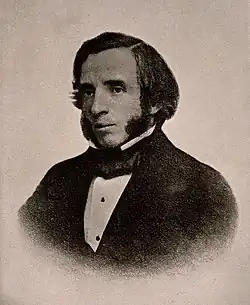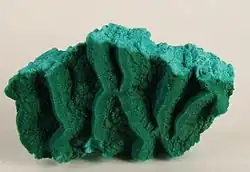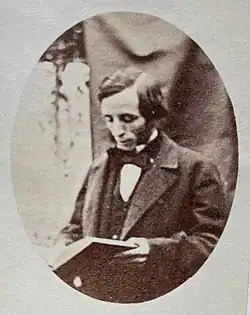Samuel Pickworth Woodward
Samuel Pickworth Woodward | |
|---|---|
 | |
| Born | 17 September 1821 Norwich, England |
| Died | 11 July 1865 (aged 43) Herne Bay, England |
| Resting place | Highgate Cemetery |
| Spouse |
Elizabeth Teulon (m. 1845) |
| Children | |
| Father | Samuel Woodward |
| Scientific career | |
| Institutions | British Museum Royal Agricultural College |
Samuel Pickworth Woodward (17 September 1821 – 11 July 1865) was an English geologist and malacologist.
Biography

Woodward was born 17 September 1821 on Briggs Lane in Norwich, which was named after the former mayor of Norwich Augustine Briggs. Today, the street is known as Brigg Street.[1] Woodward was the second son of Samuel Woodward, a clerk at Gurney's Bank, geologist, and antiquary. At the age of seven, Woodward was placed at the priory school at Greyfriars in Norwich.[2]
In 1845, S. P. Woodward became the professor of geology and natural history in the Royal Agricultural College, Cirencester. On 29 November, 1845, the council of the Botanical Society of London appointed him local secretary for the county of Gloucester. Also in 1845, Woodward married Elizabeth Teulon, the eldest daughter of John Teulon.[2] Woodward's father-in-law John Teulon may have been the printer who was sentenced on 26 October 1838 "to fifteen months imprisonment for attempting to extort money from the Duke of Devonshire, by the pamphlet entitled 'The Secret History,' relating to the late Lady Mary Hill",[3] who accidentally burned to death at her home at the age of 85.[4]
In 1848 he was appointed assistant in the department of geology and mineralogy in the British Museum.[5]
He was author of A Manual of the Mollusca (in three parts, 1851, 1853 and 1856).
He proposed the term Bernician Series for the lower portion of the Carboniferous System, below the Millstone Grit.


In early 1865 Woodward's frequent asthma attacks led him to go on sick leave. He later went to Herne Bay in hopes of recuperating his health. He died on 11 July 1865, after rupturing an artery in his lung. Woodward was buried on the eastern side of Highgate Cemetery.
Woodwardite, a hexagonal mineral containing aluminum, copper, hydrogen, oxygen, and sulphur, was described as a new mineral species by Church (1866) and named in honour Samuel Pickworth Woodward; its (type locality was given only as Cornwall.[6][7]
Family
His son Bernard Henry Woodward moved to Australia and was a museum director of the Western Australian Museum.[8] His other son Horace Bolingbroke Woodward was president of the Geologists' Association from 1893–1894.[9] His nephew Bernard Barham Woodward was a British malacologist and a member of staff at the British Museum and the Natural History Museum.[10]
Bibliography
- A Manual of the Mollusca (in three parts, 1851, 1853 and 1856).
- (in French) Fischer P., Oehlert P. & Woodward S. P. (1885-1887). Manuel de conchyliologie et de paléontologie conchyliologique ou histoire naturelle des mollusques vivants et fossiles suivi d'un appendice sur les brachipodes. Avec 23 planches contenant 600 figures et 1138 gravures dans le texte. pp. I-XXIV, pp. 1–1369, Plates I-XXIII, 1 map. Paris.
References
- ^ Prickett, Katy. "Norwich grocer's story mirrors 17th Century highs and lows". BBC.
- ^ a b Woodward, Horace Bolingbroke (1882). "A Memoir of Dr. S. P. Woodward, A.L.S., F.G.S., &c. with a List of His Published Papers.". Transactions of the Norfolk & Norwich Naturalists' Society; Presented to the Members for 1881–82. Vol. III. Norwich: Fletcher and Son.
- ^ Irving, Joseph (1869). The Annals of Our Time. London: Macmillan and Co. p. 9.
- ^ Forster, Henry Rumsey (1851). The Pocket Peerage of Great Britain and Ireland. London: David Bogue, Fleet Street. p. 280 – via the Internet Archive.
- ^ "Samuel Pickworth Woodward, 1821–65 :: Darwin Correspondence Project". Darwin Correspondence Project. Retrieved 29 May 2010.
- ^ Church, A. H., 1866. J. Chem. Soc. 19, p. 131.
- ^ "Woodwardite: Woodwardite mineral information and data". Mindat.org. Retrieved 29 May 2010.
- ^ Crawford, Ian M. (1990). "Woodward, Bernard Henry (1846–1916)". Australian Dictionary of Biography. National Centre of Biography, Australian National University.
- ^ "Horace Bolingbroke Woodward, F.R.S., F.G.S." (PDF). University of Cambridge.
- ^ "Bernard Barham Woodward" (PDF). University of Cambridge.
External links
 Works by or about Samuel Pickworth Woodward at Wikisource
Works by or about Samuel Pickworth Woodward at Wikisource- Works by or about Samuel Pickworth Woodward at the Internet Archive